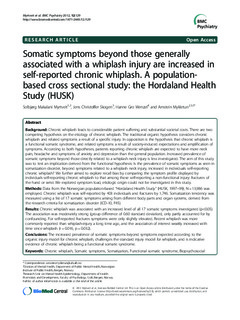| dc.contributor.author | Myrtveit, Solbjørg Makalani | |
| dc.contributor.author | Skogen, Jens Christoffer | |
| dc.contributor.author | Wenzel, Hanne Gro | |
| dc.contributor.author | Mykletun, Arnstein | |
| dc.date.accessioned | 2015-09-11T13:11:57Z | |
| dc.date.accessioned | 2015-09-28T11:17:27Z | |
| dc.date.available | 2015-09-11T13:11:57Z | |
| dc.date.available | 2015-09-28T11:17:27Z | |
| dc.date.issued | 2012 | |
| dc.identifier.citation | BMC Psychiatry 2012, 12(1) | nb_NO |
| dc.identifier.issn | 1471-244X | |
| dc.identifier.uri | http://hdl.handle.net/11250/302192 | |
| dc.description.abstract | Background: Chronic whiplash leads to considerable patient suffering and substantial societal costs. There are two
competing hypothesis on the etiology of chronic whiplash. The traditional organic hypothesis considers chronic
whiplash and related symptoms a result of a specific injury. In opposition is the hypothesis that chronic whiplash is
a functional somatic syndrome, and related symptoms a result of society-induced expectations and amplification of
symptoms. According to both hypotheses, patients reporting chronic whiplash are expected to have more neck
pain, headache and symptoms of anxiety and depression than the general population. Increased prevalence of
somatic symptoms beyond those directly related to a whiplash neck injury is less investigated. The aim of this study
was to test an implication derived from the functional hypothesis: Is the prevalence of somatic symptoms as seen in
somatization disorder, beyond symptoms related to a whiplash neck injury, increased in individuals self-reporting
chronic whiplash? We further aimed to explore recall bias by comparing the symptom profile displayed by
individuals self-reporting chronic whiplash to that among those self-reporting a non-functional injury: fractures of
the hand or wrist. We explored symptom load, etiologic origin could not be investigated in this study.
Methods: Data from the Norwegian population-based “Hordaland Health Study” (HUSK, 1997–99); N = 13,986 was
employed. Chronic whiplash was self-reported by 403 individuals and fractures by 1,746. Somatization tendency was
measured using a list of 17 somatic symptoms arising from different body parts and organ systems, derived from
the research criteria for somatization disorder (ICD-10, F45).
Results: Chronic whiplash was associated with an increased level of all 17 somatic symptoms investigated (p<0.05).
The association was moderately strong (group difference of 0.60 standard deviation), only partly accounted for by
confounding. For self-reported fractures symptoms were only slightly elevated. Recent whiplash was more
commonly reported than whiplash-injury a long time ago, and the association of interest weakly increased with
time since whiplash (r = 0.016, p = 0.032).
Conclusions: The increased prevalence of somatic symptoms beyond symptoms expected according to the
organic injury model for chronic whiplash, challenges the standard injury model for whiplash, and is indicative
evidence of chronic whiplash being a functional somatic syndrome. | nb_NO |
| dc.language.iso | eng | nb_NO |
| dc.publisher | BioMed Central | nb_NO |
| dc.title | Somatic symptoms beyond those generally associated with a whiplash injury are increased in self-reported chronic whiplash. A population-based cross sectional study: the Hordaland Health Study (HUSK) | nb_NO |
| dc.type | Journal article | nb_NO |
| dc.type | Peer reviewed | en_GB |
| dc.date.updated | 2015-09-11T13:11:57Z | |
| dc.subject.nsi | VDP::Medisinske fag: 700::Klinisk medisinske fag: 750::Psykiatri, barnepsykiatri: 757 | nb_NO |
| dc.subject.nsi | VDP::Midical sciences: 700::Clinical medical sciences: 750::Psychiatry, child psychiatry: 757 | nb_NO |
| dc.source.volume | 12 | nb_NO |
| dc.source.journal | BMC Psychiatry | nb_NO |
| dc.source.issue | 1 | nb_NO |
| dc.identifier.doi | 10.1186/1471-244X-12-129 | |
| dc.identifier.cristin | 946225 | |
| dc.subject.keyword | Helseplager / Health complaints | |
| dc.subject.keyword | Nakkesleng / Whiplash | |
| dc.subject.keyword | Norge / Norway | |
| dc.subject.keyword | Psykosomatikk / Psychosomatic medicine | |
| dc.description.localcode | © 2012 Myrtveit et al.; licensee BioMed Central Ltd. This is an Open Access article distributed under the terms of the Creative Commons Attribution License (http://creativecommons.org/licenses/by/2.0), which permits unrestricted use, distribution, and reproduction in any medium, provided the original work is properly cited. | nb_NO |
